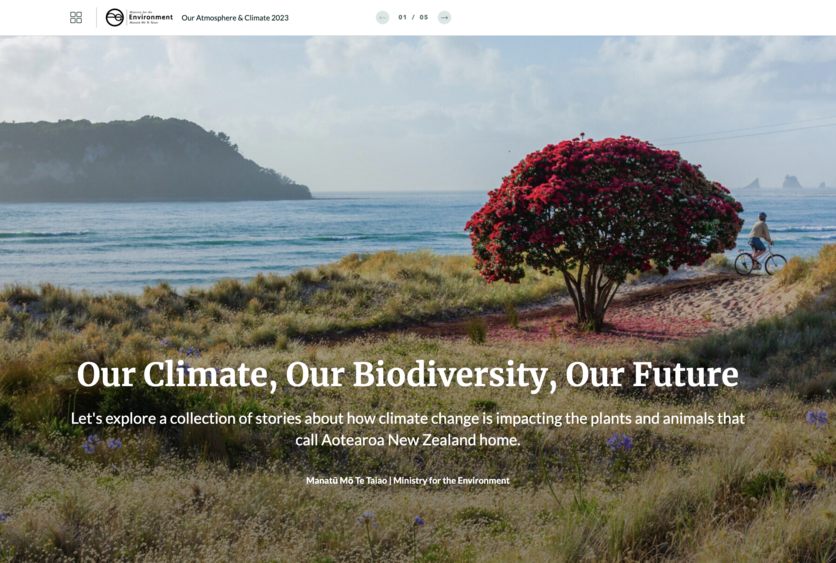Our climate, our biodiversity, our future is an interactive storymap that uses a collection of stories arranged to show the interconnectedness of ki uta ki tai – mountains to the sea, which illustrates how the climate is changing, how it impacts our indigenous biodiversity and what is being done to help.
The stories illustrate the complexity of climate change impacts on ecosystems and how the impacts cascade and amplify the threats from invasive species and human disturbance.
Stories explore the impacts of:
- glacier loss and changes in alpine habitats
- predator plague cycles
- freshwater species loss and implications for mahinga kai
- ocean acidification and warming on marine food webs
- extreme weather events
- pressures on indigenous knowledge
- actions to protect our natural taiao and biodiversity.
The storymap was created by the Ministry for the Environment as an interactive product that allows users to explore data and findings from the environmental report Our atmosphere and climate 2023.
Temperature rise is only the beginning of the story. Because the Earth is a system where everything is interconnected, changes in one area can influence changes in all others. Climate change is already having widespread effects on our environment and wellbeing in Aotearoa New Zealand.
Our atmosphere and climate 2023
In this activity, students use a browser-based storymap to consider the impacts of climate change via the complex interconnections of ki uta ki tai – mountains to the sea. The effects of climate change in one part of the ecosystem can have significant impacts on other parts of te taiao.
By the end of this activity, students should be able to:
- progress through the Our climate, our biodiversity, our future storymap
- interact with data used in Our atmosphere and climate 2023 via interactive maps
- use media and text to explore stories about climate and biodiversity
- consider how effects in one part of the environment can have cascading effects due to the complexity of interacting systems
- consider what actions they can take to help mitigate the effects of climate change.
Download the Word file (see link below).
Nature of science – communicating in science
Stats NZ and the Ministry for Environment report on different aspects of the state of the environment. The storymaps that accompany the reports also communicate the state of the environment but in a less formal manner. They are designed to add context and personal meaning to the environmental issues, create conversations and elicit a response.
Related content
Professional development resources:
- Climate change – classroom competencies has suggestions for developing student competencies and working towards climate solutions.
- Climate change resources – planning pathways provides pedagogical advice and links to the New Zealand Curriculum. It includes an interactive planner that groups Hub resources into key science and teaching concepts.
- Climate change – a wicked problem for classroom inquiry offers ideas on how to use an inquiry approach when teaching about climate change.
- Thin Ice in the classroom curates climate change resources and provides curriculum information.
Climate change resource curations:
- Our atmosphere and climate – introduction curates a suite of resources developed in collaboration with the Ministry for the Environment and Stats NZ. Resources highlight climate connections and implications for Aotearoa and for Māori. They have a strong focus on evidence and data.
- Our atmosphere and climate 2020 – a collection focusing on the 2020 report.
- Climate change – a collection with a focus on the science of climate change and associated socio-scientific issues, including melting ice and sea-level rise.
- Climate change (HoS) supports the House of Science Climate Change resource kit but it is also useful for anyone exploring what is climate change, ocean acidification, sea and land water, how climate change affects Māori, the Earth’s interacting systems and ideas to tackle these wicked problems in the classroom.
Useful links
Stats NZ and the Ministry for the Environment report on the state of different aspects of the environment every 6 months and the environment as a whole every 3 years. Find their reports here.
Acknowledgement
This resource has been produced with the support of the Ministry for the Environment and Stats NZ. © Crown copyright.


